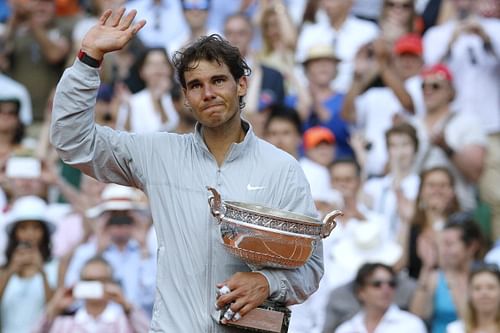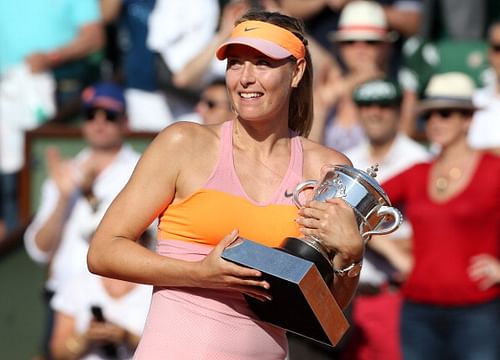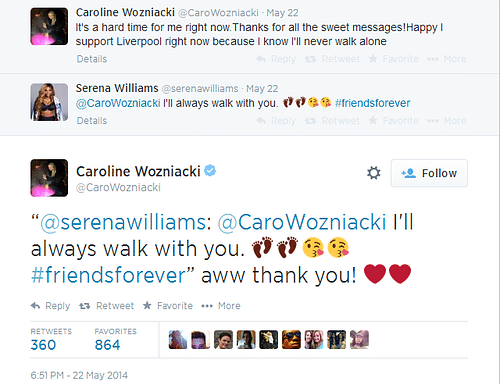
French Open 2014: 10 takeaways from the tournament
The second Grand Slam of the year came to a magnificent end yesterday with Spaniard Rafael Nadal winning his ninth title in 10 years at Roland Garros. The historical event capped what has been an interesting fortnight of tennis. While there was a certain predictability to the men’s side, the women’s draw threw up more surprises than ever before.
The Parisian clay has always favoured some and troubled others, given that you need certain special skills to thrive on the surface. But if Maria Sharapova, who once likened herself to a “cow on ice” while playing on clay, can win two titles here, then let’s just say that it can be done if one is willing to work hard and play harder. On that note, let’s take a look at some of the key takeaways from this year’s tournament
1. Rafael Nadal equals Pete Sampras’ tally of 14 Grand Slam titles with his ninth win at RG. Instead of doling out unbelievable statistics about his achievements, I would suggest you read this piece on him: Defeating Rafael Nadal at the French Open? In one word – impossible.

2. The Curious Case of Novak Djokovic: That the Serb is supremely talented has been established beyond doubt. That he can defeat Nadal, Murray, Federer and any other player on tour is obvious from his accomplishments. Yet, from June 2012, he has played in six Grand Slam finals and won just one. In fact, his overall Grand Slam finals record is 6 wins in 13 Slam finals, for a success ratio of less than 50% (compare this to Nadal or Federer who both have success ratio of 70%). Perhaps it is not fair to Djokovic to examine this loss given that defeating Nadal at RG is near impossible. What should be examined though is his physical endurance during the match which he admitted to having struggled with. The good thing for him is that the action now moves to grass, and then later to the hard courts where Djokovic has had considerable success in the past.
3. Iron Woman – Maria Sharapova: I had not fancied Maria’s chances at the start of the event. Despite having made two successive finals and winning the title in 2012, many people thought that the obstacle, also known as Serena Williams, would be insurmountable for the Russian. When Williams lost shockingly in the second round after Li Na’s exit, Maria seemed like a safer bet. Her road to the final was not easy though. She played four consecutive three-set matches to stake her claim as the Queen of Clay; the run included a fascinating comeback against Sam Stosur in the 4th round and against Eugenie Bouchard in the semis.
Maria not only has two French Open crowns but also nine claycourt titles, making her one of the most successful active players on the surface (Spaniard Anabel Medina Garrigues and Serena Williams have 10 claycourt titles each). Throughout the tournament, Sharapova’s never-say-die attitude and nerves of steel were her biggest weapons. She overcame inconsistent serving and some inspired opponents through sheer determination. Isn’t that a refreshing sight when there are constant comments about lack of mental strength and inconsistency on the women’s tour?

4. Rising stars – Simona Halep and Eugenie Bouchard: Simona Halep, the 22-year-old Romanian ranked no. 4 at the start of the tournament (she has risen to no. 3 with this final) was the most remarkable story of this year’s Roland Garros. She was ranked 57 in the world this time last year, and rose through the ranks on the back of six titles last season. Her Grand Slam record has been relatively poor though, having made it past the fourth round only once – at this year’s Australian Open. She lost in the first round at the French Open last year, but many experts predicted her to do better this time around given that she had a relatively easy draw on paper. Enroute her maiden Slam final, she did not drop a single set and played fantastic tennis. I, for one, thought that nerves and inexperience would get to Simona given the ocassion but credit to her for taking the fight to Sharapova, something which the Russian herself acknowledged in her post match interview; the Russian admitted that this was the toughest final she had ever played.
The other bright spot in the women’s draw was 20-year-old Canadian rising star Eugenie Bouchard. After reaching the semifinals at the Australian Open this year, many expected Bouchard to march ahead on the tour. Surprisingly, she did not rake up the wins in the WTA tournaments and was particularly unimpressive on the claycourts. Her performance at RG though was anything but unimpressive. She demolished No. 8 seed Angelique Kerber and showed great maturity in her match against No. 14 seed Carla Suarez Navarro. She started great in her semifinal against Maria Sharapova by playing aggressive tennis, only to be let down by that same tactic as the match progressed. Despite her semifinal loss though, Bouchard now rises to No. 12 in the world and looks well on her way to becoming a star.
5. “Mr. Motormouth” Ernest Gulbis: Like him or hate him, you cannot ignore the fact that Gulbis, ranked a career high 17 (he has now risen to No. 10) in the world, knows how to make a statement. Notwithstanding his comments about women playing tennis and his friendship gone sour with Djokovic, Gulbis walked the talk this time by reaching his maiden Slam semifinal. Buoyed by a fantastic win against Federer and a sharp first serve, he made his way through the draw defeating the likes of 6th seed Berdych in straight sets. He even managed to take a set off Novak Djokovic in the semis. Overall, it is a result that Gulbis would have happily taken at the start of the tournament, and now the whole world will wait and see what the temperamental Latvian does next.
6. Hello Andy Murray: Andy Murray has long been in the shadows of Djokovic, Federer and Nadal. Maybe it is his personality, but the only way he remains a conversation topic is when he wins a Slam, which has done the past two years. After his Wimbledon win last year though, Murray has had plenty of troubles. He underwent surgery for his lower back problems which had incidentally caused him to withdraw from last year’s French Open. He dropped to No. 6 in the world and was seeded 7th for this year’s tournament. Considering the context, he should be happy with his semifinal result this time given that he overcame some tough competitors in five-set matches (def. Philipp Kohlschreiber 12-10 in the deciding set, def. Gael Monfils 6-0 in the fifth set in a strange match). With the appointment of Amelie Mauresmo as his coach in what many are calling a historic move, it remains to be seen how he goes about defending his title at Wimbledon.
7. What next for the Swiss?: Both Roger Federer and Stanislas Wawrinka were expected to do better than they eventually did. Wawrinka lost to 41st-ranked Guillermo Garcia-Lopez in the first round without much of a fight. In fact, his form since his victory at Australian Open earlier this year has been topsy turvy to say the least. Ranked No. 3 in the world now, he is no longer the second fiddle to Federer and carries expectations on his shoulder. His record at Wimbledon has been horrible (three first round exits in four years), and it will be interesting to see if he can pick himself up.
As for Federer, nobody expected him to win the title here. Clay is his least favorite surface and he came into the tournament without much practice. Also, he recently became father to twin boys which, let’s be honest, can take away from your preparation – both physically and emotionally. Yet, losing the way he did, in the fourth round to Latvian Ernest Gulbis, suggests that expecting him to make it into the second week of Grand Slams should not be taken for granted anymore. His best chance of winning another Grand Slam is at Wimbledon, his favourite hunting ground. At 33, he is not getting any younger, and he is playing a sport which is getting increasingly more physical. Here’s hoping he regains his mojo.
8. All the good men: Let’s focus on the other notable men in the draw. No. 6 seed Thomas Berdych was not expected to lose against Gulbis but his emphatic defeat once again calls into question whether he can break through at the Grand Slams. Bringing in deja vu was Spaniard David Ferrer who, after his defeat at the hands of compatriot Rafael Nadal, suggested that he gave up on the match knowing he could not beat the Mallorcan. Expectations were high from rising Japanese star Kei Nishikori who gave a good account of himself in the clay season only to withdraw from the Madrid finals due to an injury. He lost in the first round this year. Hopefully, he recovers for Wimbledon.
The two Frenchmen – Jo-Wilfried Tsonga and Gael Monfils – are entertainers. They are loved unequivocally not just by the French crowd, but by viewers around the world. Tsonga post his knee injury last year has not had the best results, and only time will tell if he can recover to compete with the best once again. As for Monfils, several people were critical of his on-court histrionics during the Murray quarterfinal, dubbing them as unnecessary theatre. But Monfils is unpredictable, and that’s his strength. Grass has never been his best surface, but if he focuses on his game and does not dive around trying to injure himself, he could at least make it to the second week.
9. The other top ladies: The women’s draw is always a puzzle, especially at the Grand Slams. Except for Serena Williams, the consistency of the other top players in the Slams has been questionable to say the least. With the American No. 1’s exit in the second round, the draw opened up. No. 2 seed Li Na lost in the first round. No. 3 Agnieszka Radwanska lost to Ajla Tomljanovic, ranked No. 72 in the world in straight sets, once again bringing into question her lack of a power game and her mediocre serve. Former Wimbledon champion and No. 5 seed Petra Kvitova lost in the third round to experienced clay courter Svetlana Kuznetsova, but gave a good acount of herself in the match. She has struggled with injuries and her movement for quite some time now, but the sheer talent she possesses makes me optimistic that she will regain her form. Another positive sign was Andrea Petkovic’s performance. She played wonderful tennis through the draw to reach the semifinals where she eventually lost to Halep, but this result should certainly boost her morale.
10. Of heartbreaks and personal struggles: One of the off court stories that caught everyone’s attention was that of Danish former world no. 1 Caroline Wozniacki. Just before the start of the tournament, her fiancee, golfer Rory McIlroy called off their engagement, declaring he was not ready for marriage after sending out wedding invites. It sounds awful and certainly seemed to affect Wozniacki who bowed out of the event in the first round. Adding salt to her wounds, Rory won the BMW PGA Championship the same week. From hanging out with Serena Williams in Miami post her break-up to posting inspirational and cryptic quotes on Twitter, this story continues to be a talking point.

That more or less wraps up the 113th edition of the French Open and also brings to an end the claycourt season. Can anybody beat Rafael Nadal at Roland Garros? Will Djokovic fulfill his dream of a Career Slam? Will Serena win her third title here becoming one of the few players to have won every Grand Slam at least thrice? Will the American players ever embrace clay the way Andre Agassi did? For all these answers and more, we will have to wait for next year.
Until then, let’s roll out the green grass!